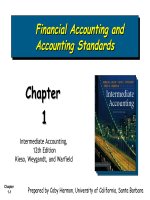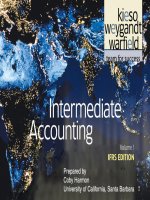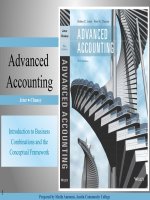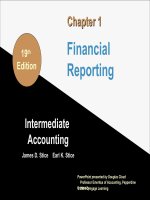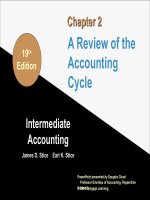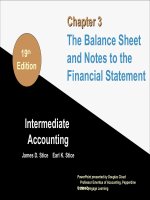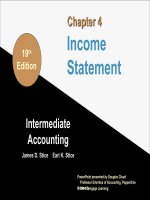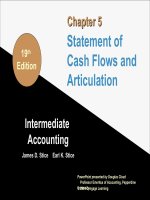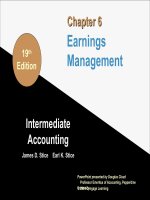Intermediate accounting 19th by stice stice chapter 01
Bạn đang xem bản rút gọn của tài liệu. Xem và tải ngay bản đầy đủ của tài liệu tại đây (182.53 KB, 59 trang )
Chapter 1
19th
Edition
Financial
Reporting
Intermediate
Accounting
James D. Stice
Earl K. Stice
PowerPoint presented by Douglas Cloud
Professor Emeritus of Accounting, Pepperdine
University
© 2014 Cengage Learning
1-1
Definition of Accounting
“Accounting is a service activity. Its
function is to provide quantitative
information, primarily financial in nature,
about economic entities that is intended to
be useful in making economic decisions—
in making reasoned choices among
alternative courses of action.”
Statement of the Accounting Principles Board No. 4, par. 40.
(continued)
1-2
Definition of Accounting
Key features in this definition of accounting:
•
Accounting information is used in making
decisions about how to allocate scarce
resources.
•
Although accountants place much emphasis
on reporting what has already occurred, this
past information is intended to be useful in
making economic decisions about the future.
1-3
Users of Accounting Information
•
•
•
Stakeholders are all parties interested in the
financial health of a company.
Internal users are stakeholders who make
decisions that directly affect the internal
operations of the enterprise.
External users are stakeholders who make
decisions concerning their relationship to the
enterprise.
1-4
Users of Accounting Information
1. Management accounting is concerned
primarily with financial reporting for internal
users, especially management.
2. Financial accounting focuses on the
development and communication of
financial information for external users.
a. Helps users in determining whether a
company’s operations are profitable
enough to justify additional funding.
(continued)
1-5
Users of Accounting Information
b. Helps users in determining how risky
a company’s operations are in order
to determine what rate of return is
necessary to compensate capital
providers for the investment risk.
1-6
External Investors
Creditors
Creditors need
need
information
information about
about the
the
profitability
profitability and
and
stability
stability of
of the
the
company
company to
to decide
decide
whether
whether to
to lend
lend
money
money to
to the
the
company
company and,
and, ifif so,
so,
what
what interest
interest rate
rate to
to
charge.
charge.
Investors
Investors (both
(both
existing
existing stockholders
stockholders
and
and potential
potential
investors)
investors) need
need
information
information
concerning
concerning the
the safety
safety
and
and profitability
profitability of
of
their
their investment.
investment.
1-7
General-Purpose Financial
Statements
The balance sheet reports, as of a
certain point in time, the resources
of a company (the assets), the
company’s obligations (the
liabilities), and the equity of the
owners.
(continued)
1-8
General-Purpose Financial
Statements
The income statement reports, for a
certain interval, the net assets
generated through business
operations (revenues), the net assets
consumed (the expenses), and the
difference, which is called net
income.
(continued)
1-9
General-Purpose Financial
Statements
The statement of cash flows
reports, for a certain interval, the
amount of cash generated and
consumed by a company through
the following three types of
activities: operating, financing, and
investing activities.
(continued)
1-10
General-Purpose Financial
Statements
Accounting estimates and
judgments are outlined in the notes
to financial statements. In
addition, the notes contain
supplemental information as well as
information about items not
included in the financial statements.
1-11
Auditor’s Role
•
Auditors, working independently of a
company’s management and internal
accountants, examine the financial
statements.
•
They issue an auditor’s opinion about
the fairness of the statements and their
adherence to proper accounting
principles.
1-12
The FASB
•
The Financial Accounting Standards
Board (FASB) sets accounting
standards in the United States.
•
The FASB is a private-sector body and
has no legal authority.
•
The issuance of new accounting
standards is preceded by a lengthy public
discussion.
(continued)
1-13
The FASB
•
The Emerging Issues Task Force
(EITF) works under the direction of the
FASB.
•
The EITF formulates a timely expert
consensus on how to handle new
issues not yet covered in FASB
pronouncements.
(continued)
1-14
The FASB
• The Securities and Exchange
•
Commission (SEC) was created by the
1933 Securities Act to protect the interests
of investors by ensuring full and fair
disclosure.
It was given specific legal authority to
establish accounting standards for
companies desiring to publicly issue shares
in the United States.
(continued)
1-15
The FASB
• The SEC has generally allowed the
private-sector organizations to make the
accounting standards in the United States
(commonly referred to as generally
accepted accounting principles
(GAAP)).
(continued)
1-16
The FASB
• The Financial Accounting Standards
Board (FASB) is currently recognized as the
private-sector body responsible for the
establishment of U.S. accounting standards.
• The FASB was organized in 1973, replacing
•
the Accounting Principles Board (APB).
Five full-time members are drawn from a
variety of backgrounds—auditing, corporate
accounting, financial services, and academia.
(continued)
1-17
The FASB
• Appointment of new Board members is
done by the Financial Accounting
Foundation (FAF).
• The FAF serves somewhat like a board of
directors overseeing the FASB.
• The FAF is also responsible for selecting
and supporting members of the
Governmental Accounting Standards
Board (GASB).
(continued)
1-18
The FASB
•
The major functions of the FASB are to
study issues and to establish accounting
standards.
•
These standards are published as
Accounting Standards Updates.
•
The FASB has also issued Statements of
Financial Accounting Concepts that
provide a framework within which specific
accounting standards can be developed.
1-19
FASB “Due Process”
1. FASB staff assembles background information
and the Board holds public meetings before a
decision is made to even add a project to the
FASB’s formal agenda.
2. After more study and further hearings, the
Board often issues a report summarizing its
Preliminary Views.
3. Interested parties are invited to comment either
in writing or orally at a public hearing.
(continued)
1-20
FASB “Due Process”
4. After comments from interested parties have
been evaluated, the Board meets as many
times as necessary to resolve the issues.
5. From these meetings, the Board develops an
Exposure Draft of a statement that includes
specific recommendations for financial
accounting and reporting.
6. After 60 days or longer, if the topic is a major
one, all comments are reviewed by the staff and
the Board.
(continued)
1-21
FASB “Due Process”
7. Further deliberation of the Board leads to either
the issuance of an Accounting Standards
Update, a revised Exposure Draft, or, in some
cases, abandonment of the project.
8. The final statement not only sets forth the actual
standards but also establishes the effective
date and method of transition.
9. Currently, a simple majority (three out of five) is
required for approval of an Exposure Draft or a
final statement of standards.
1-22
Emerging Issue Task Force
• In an effort to overcome the methodical,
sometimes slow, nature of the standard
setting process, in 1984 the FASB
established the Emerging Issues Task
Force (EITF).
• The EITF assists the FASB in the early
identification of emerging issues that affect
financial reporting.
1-23
FASB Accounting Standards
Codification
• The official source of U.S. GAAP is called
the FASB Accounting Standards
Codification (ASC).
• Prior to launching of the FASB ASC in July
2009, finding a specific accounting rule on a
specific topic involved a primitive hunt-andpeck strategy.
1-24
Securities and Exchange
Commission (SEC)
•
•
•
•
The SEC was created by an act of Congress in
1934.
Its primary role is to regulate the issuance and
trading of securities by corporations to the
general public.
It requires companies to furnish various
financial statements, and other periodic
information about significant events.
The SEC requires companies to have their
external financial statements audited by
independent accountants.
(continued)
1-25
